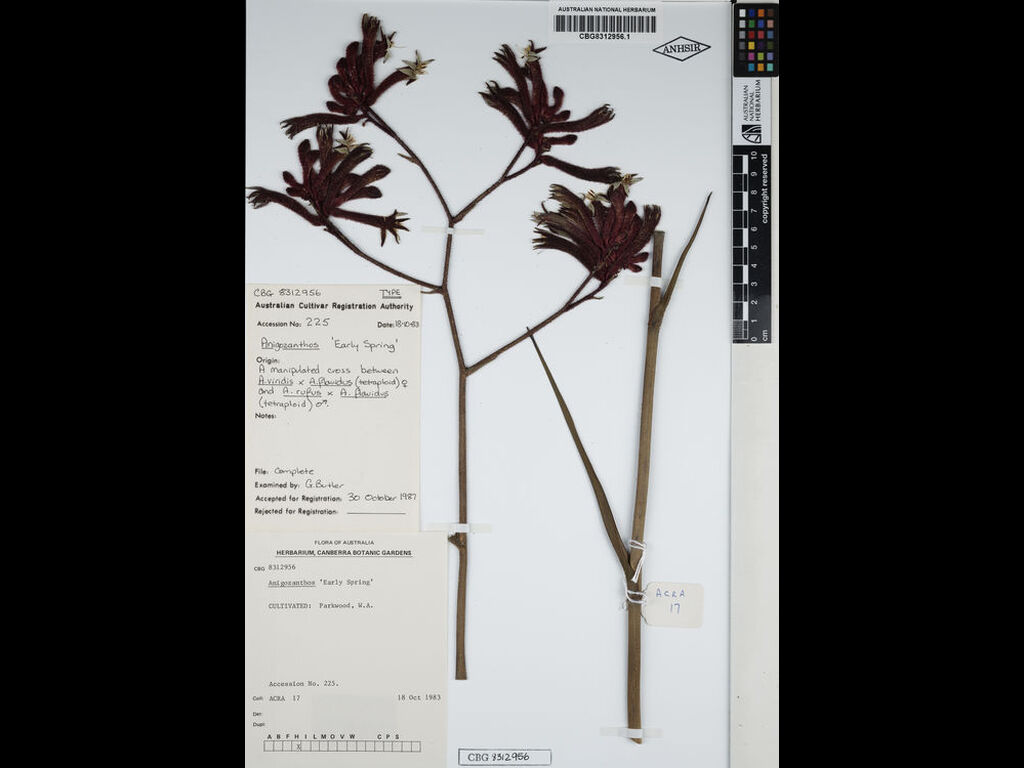Anigozanthos 'Early Spring'
- File Number
- 225
- ACRA Field Book Number
- 17
- Registration Date
- 29/10/1987
- Application Received
- 01/09/1980
- Family
- Haemodoraceae
- Cultivar Name
- Anigozanthos 'Early Spring'
- Origin
- Anigozanthos 'Early Spring' is the result of a manipulated cross between A. viridisx A. flavidus (tetraploid) female and A. rufus x A. flavidus (tetraploid) male. The cross was performed by Mr K R Oliver of Western Australia.The cultivar was first received by the Authority in Septmber 1980. Registration applied for by Mr K R Oliver.
- Characteristics
- This cultivar has flowering stems to about 1.1m tall, mostly glabrous with a covering of dark purple tomentose hairs. The flowers are on terminal branchlets which are divaricately branched. The flowers have pedicels to about 4mm long. The wool on the flowers is dark red, plumose over the whole surface with occasional yellow green hair giving them a slightly dusty appearance. The perianth tube is around 45mm long, glabrous inside and minutely scabrous dotted below the middle. The perianth loves are about 10mm long with dense woolly yellow green and sometimes orange plumose hairs inside. The anthers ar shorter than the filaments, the connective tipped with a reduced gland like appendage. The ovules are about 6 per locule. Diagnosis: The flowers of Anigozanthos 'Early Spring' have the colouring of A. rufus. They are similar in length to A. flavidus but broader than A. flavidus or A. viridis and not as broad as A. rufus. The bracts are narrower and less hairy than A. rufus but broader than those in A. flavidus . The stems are more hairy than A. rufus. The leaves are much broader and not as long as A. viridis. The ovary is less prominent than in A. flavidus . Anigozanthos 'Early Spring' does not grow as tall as A. rufus.
- Cultivation
- Anigozanthos 'Early Spring' is unpalatable to snails and is Ink disease resistant. It is fertile and of perennial habit. This cultivar is semi-hardy to drought and has a long flowering season (July to November in Western Australia). It has been in cultivation since 1971. This cultivar is reported to be very tolerant of the humid conditions that often occur in Brisbane as compared to many other hybrid Anigozanthos.
- Publication
- Wrigley, J.W. & Fagg, M. (1988), Australian Native Plants: propagation, cultivation and use in landscaping Edn. 3: 109
- Colour Coding
- RHS Colour Code 1966.plumose hairs: red group 53A-B.anthers: greyed yellow group 162A.filaments: yellow green group 145A.stems: close to greyed pruple group 187A.
- Propagation
- Division or tissue culture
- Applicant Name
- K. Oliver
- Uses
- As part of a mass planting or mixed in a shrubbery, or as a spectacular feature plant. Attracts nectar feeding birds.
- Availability
- Unknown
- ANBG Accession Numbers
- ACC225; ACRA017; CBG8312956.
- NSL ID
- -

